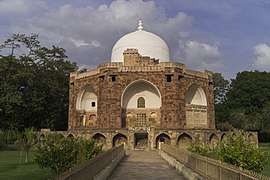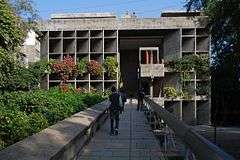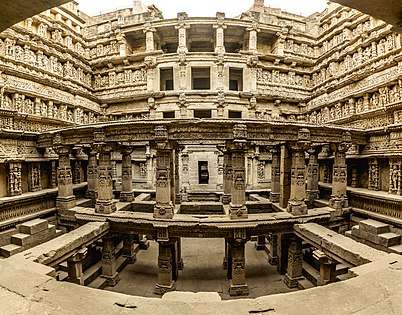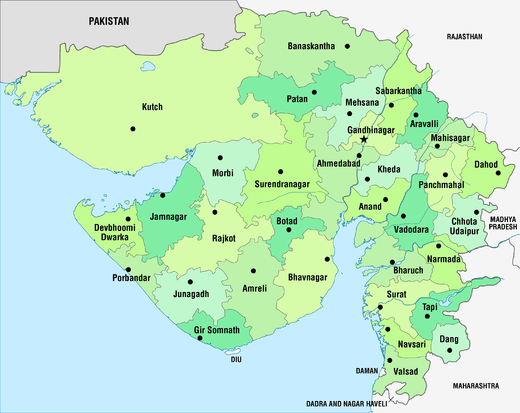Architecture of Gujarat
The Architecture of Gujarat consists of architecture in the Indian state of Gujarat.
The first major civilization in Gujarat was the Harappan Civilization. Their settlements, including Dholvaira and Lothal are characteristic of Harappan architecture.
Indo-Islamic architecture flourished during the rule of the Gujarat Sultanate and Mughal Empire in Gujarat. Buildings were built in European styles, including Gothic and Neoclassical during the British Colonial period. Indo-Saracenic architecture also developed during this period. After independence in 1947, modernist architecture is seen in Gujarat.
Ancient period

Hindu temple architecture
Medieval Hindu Temple architecture is seen in the Kalika Mata Temple[2], Dwarkadish Temple, and Somnath temple.
Chaulukya architecture
The Chaulukya dynasty ruled between the 10th and 13th centuries CE.
Examples of Chaulukya architecture include Taranga Jain temple, Rudra Mahalaya Temple, and Modhera Sun Temple. The Rani ki vav was also built during this period.[3]
Indo-Islamic architecture

The first Muslim dynasty to rule large parts of Gujarat was the Delhi Sultanate in the 14th century. Gujarat would later be ruled by the Mughal empire, Gujarat Sultanate, and several Muslim-ruled princely states until 1947. Thus, Indo-Islamic architecture is found all over the state.
Mughal
Mughal architecture in Gujarat includes the Hazira Maqbara in Vadodara, and Mughal Sarai in Surat.
British Colonial architecture (1858-1947 CE)

During the British colonial period, Gujarat was ruled by several princely states, the rulers of which designed elaborate palaces and public buildings. These were built in various Indo-European styles.
Gothic
Gothic buildings in Gujarat include the Prag Mahal designed by Henry Saint Clair Wilkins.
Indo-Saracenic
The Indo-Saracenic buildings in Gujarat includes the Vijaya Vilas Palace in Mandvi, Laxmi Vilas Palace and Nyay Mandir in Vadodara. The Maharaja Sayajirao University was designed by Robert Chisholm.
Post-Independence (1947 CE - present)
Modernist

Le Corbusier, was invited to Ahmedabad in the 20th century by the mill owners to design their villas as well as some public buildings. The Sanskar Kendra, Villa Sarabhai, Villa Shodhan, and Mill Owners' Association Building in Ahmedabad were designed by Le Corbusier.[5]
American architect Louis Kahn designed the IIM Ahmedabad.[5]
The Premabhai Hall, Tagore Memorial Hall, and Institute of Indology in Ahmedabad were designed by B. V. Doshi, an architect who worked under both Corbusier and Louis Kahn.[6][7][8]
References
- Centre, UNESCO World Heritage. "Rani-ki-Vav (the Queen's Stepwell) at Patan, Gujarat". UNESCO World Heritage Centre. Archived from the original on 2019-09-03. Retrieved 2019-09-26.
- Centre, UNESCO World Heritage. "Champaner-Pavagadh Archaeological Park". UNESCO World Heritage Centre. Archived from the original on 2019-09-03. Retrieved 2019-09-26.
- Rahman, Azera Parveen (2019-03-16). "Make them well again: trying to save Gujarat's ancient stepwells". The Hindu. ISSN 0971-751X. Retrieved 2019-09-30.
- Centre, UNESCO World Heritage. "Historic City of Ahmadabad". UNESCO World Heritage Centre. Archived from the original on 2019-09-03. Retrieved 2019-09-26.
- Ajay, Lakshmi (2015-08-23). "Living in a cube: Corbusier designed some of Ahmedabad's most iconic buildings". The Indian Express. New Delhi. Archived from the original on 2019-09-30. Retrieved 2019-09-30.
- Bhatia, Gautam (2018-03-10). "An architecture for India: Balkrishna Doshi". The Hindu. ISSN 0971-751X. Retrieved 2019-10-01.
- Pogrebin, Robin (2018-03-07). "Top Architecture Prize Goes to Low-Cost Housing Pioneer From India". The New York Times. ISSN 0362-4331. Retrieved 2019-10-01.
- Editors, Phaidon (2018-10-17). Atlas of Brutalist Architecture. Phaidon Press. ISBN 9780714875668.CS1 maint: extra text: authors list (link)

